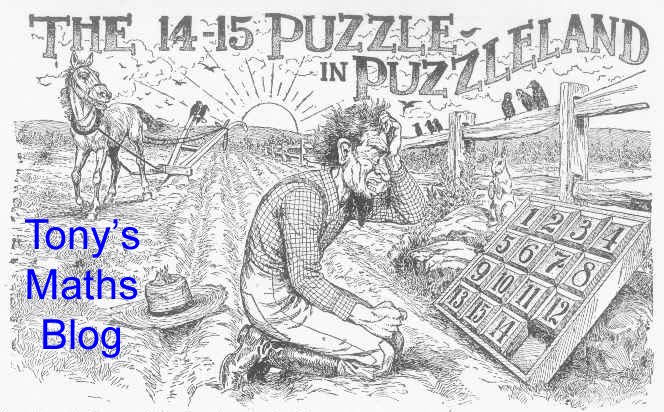Welcome to the 109th Carnival of Mathematics!
109 is a prime. I'm pleased to say that it is a happy, polite and amenable number (for definitions see, for example, www.numbersaplenty.com/109). It is a Chen prime - that is a prime number p such that p+2 is either prime or the product of two primes: in this case 111 = 3 times 37. You may remember that from Carnival 107, since 107 was also a Chen prime.
109 is the 24th term of the Euclid-Mullin sequence, a curious sequence of which each term is the smallest prime dividing the product of all the previous terms plus 1. It's motivated by Euclid's proof that there are infinitely many prime numbers. It begins 2, 3, 7, 43, 13, 53, 5, 6221671, 38709183810571, 139, 2801, 11, 17, 5471, ... and only the first 51 terms of the sequence are known, since the 52nd is the smallest prime factor of a 335-digit number of which the divisors haven't yet been found.
If we express 1/109 as a decimal, the last six digits of the recurring sequence are 853211, which gives us the first six Fibonacci numbers in reverse order.
Now to the Carnival.
It's always good to start with humour. In the last few days, xkcd has been in excellent form: here is one on teachers' statistics. And having spent much of my life writing mathematical modelling software, I particularly enjoyed PHD Comics on software testing which, as so often, hits the mark.
How about the amazing Domputer? Watch the video of the domino computer at the Aperiodical.
What does "real-world" mean with respect to maths in the classroom? dy/dan, mathalicious and Math goes Pop! have been debating this difficult question.
Maria Droujkova has claimed in an interview in Atlantic Monthly that "5-year-olds can do calculus": there is discussion at the De Morgan Forum.
GCHQ, the British Government Communications Headquarters which employs many mathematicians, has been in the news recently. Tom Leinster wrote an opinion piece for the April Newsletter of the London Mathematical Society entitled "Should Mathematicians Co-operate with GCHQ?", which can also be found (with discussion) at the n-Category Café.
Alex Bellos tells us why we all like numbers in the Guardian.
The previous host of this Carnival, MathHombre, has been using Geogebra to investigate Archimedes's twin circles.
Paul Taylor examines Rubik's Cube at the Aperiodical, examining the periods of small sequences of moves.
Jimi Cullen has been exploring model checking - a tool from computer science with applications beyond that discipline.
MathFrolic links humour with mathematics and magic in reflecting on a mind-reading trick.
Another puzzle - can you see a pattern in apparently random data - leads The Well-Tempered Spreadsheet to Melting Fractals.
The Renaissance Mathematicus tells us about a dubious account of the origins of Newton's Principia in the American TV series Cosmos.
FlexMonkey has produced an app offering "a new type of calculator: numbers and operators appear as nodes in a network interface and the relationships between them define your calculations", which sounds intriguing. And another calculator app, Tydlig, is reviewed by Aoife Hunt at the Aperiodical.
Max Tegmark's recent book Our Mathematical Universe, which argues that our universe is mathematics, has divided readers: some think it fascinating, others say its hypothesis is untestable and therefore scientifically meaningless. For a typically entertaining discussion (which, if I understand correctly, goes along with both these views) see Scott Aaronson's blog Shtetl-Optimized on the topic.
(Aaronson's post has the the wonderful title "This review of Max Tegmark's book also occurs infinitely often in the decimal expansion of pi". If you have a slow internet connection, feel free to save time by, instead of following all the links in this edition of the Carnival, simply going through the digits of pi till you find the content. You might find some other interesting stuff on the way: if so, submit it to the next Carnival!)
From deep or possibly meaningless ideas about whether the universe is simply mathematics to a simple question about multiplication: what exactly do we mean by "6 x 4"? Here are thoughts from reflectivemaths and flyingcolours.
For those looking for serious maths, Terry Tao gives a new proof of the Cayley-Salmon Theorem. And of course Theorem of the Day features a different result every day - as I type this, today's theorem is Wagner's Theorem about planar graphs.
The wonderful lecture archive at Gresham College (disclosure: I'm a visiting professor there) contains the lectures by Raymond Flood, the Gresham Professor of Geometry: the video of the most recent lecture, on "Modelling the Spread of Infectious Diseases" should be available very soon. And don't miss Colin Wright's wonderful recent lecture on "Notations, Patterns and New Discoveries": the title in my opinion seriously undersells its entertainment value!
And finally, the game at which everyone seems to be spending all their time this month - 2048. (I also suggest you have a look at an old one - Lunar Lockout). If you've discovered 2048, you'll appreciate this from xkcd.
If you have suggestions for Carnival 110, which will be hosted by Flying Colours Maths, please submit them here.

